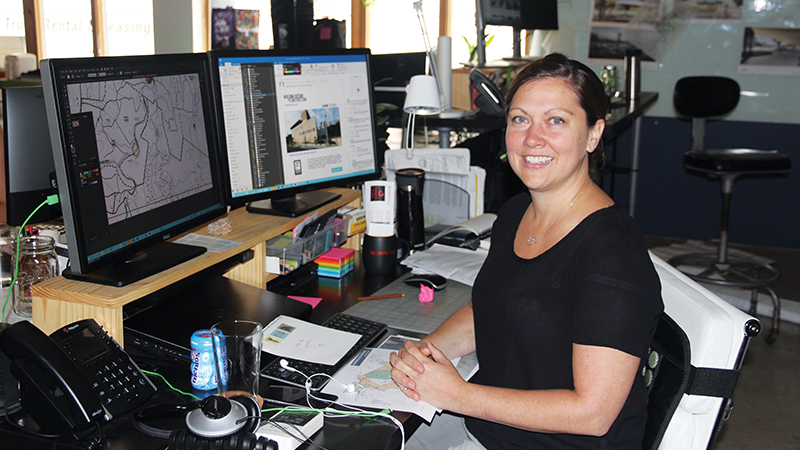Setting their SITES High: The Value of Landscape Architecture Interventions

Five years ago, when the leadership of Andropogon Associates, a Philadelphia-based landscape architecture and ecological planning firm, experienced a transition due to retirements, Emily McCoy [MLA ’08] stepped up and suggested that they do something with the shelves upon shelves of research they had kept but left largely unexplored. This included specifications from the ’80s on New York’s Fresh Kills Landfill, standards and drawings from the ’80s and ’90s in Central Park, Prospect Park, and other sites throughout the country. “There was all this institutional knowledge that I feared was going to be lost,” says McCoy. She took the lead on formalizing, archiving, and digitizing the information that had been collected. Later, the process evolved into the creation of the Integrative Research group within the firm, which seeks to “embed information learned from our 40 years of past work into our process moving forward, and then making those lessons learned open source within the profession, which was at first hard to swallow for some folks, but we decided at the end of the day this was part of our mission.”
The firm hired researchers and is committed to partnering with clients in education who will support this mission of opening their findings to the public. At the University of Pennsylvania in Philadelphia, for example, members of the firm were working across the street from researchers in the field. “We said, ‘let’s work together to understand and learn from our project and then use this information to advocate for more green infrastructure in the city.’ Now in every project, we look for these research opportunities.”
McCoy serves as an Associate Principal and the Director of Integrative Research for Andropogon, which in addition to being a research-based firm promotes building for long-term sustainability. McCoy researches “high-performing landscapes” to foster sustainable best practices in landscape architecture. She didn’t originally set out in the direction of landscape design but discovered after college that it complemented her other skills.
McCoy completed a bachelor’s degree in ecology from Appalachian State University in Boone, NC. After graduation, research positions were scarce, and she ended up working in a nursery outside of Blacksburg, VA, for three-and-a-half years. As a horticulturist there, she met a number of landscape architects and was drawn to the field. “I was exposed to landscape architects. I talked to them and grew for them and realized that there was a lot of improvement to be made with regards to planting species and types, to where they could be improved upon from an ecological perspective. There were a lot of missed opportunities.” She returned to school at night and took drafting and landscape architecture (LAR) classes. “I decided LAR was something that I felt passionate about, and it fulfilled the other side of my brain that I hadn’t been able to engage since I was an adolescent, looking at a more artistic way to express myself.” NC State’s College of Design (COD) caught her eye, especially for its service to the community. “They have gone to great strides to expose those in secondary education to the design disciplines with Design Camp and other programs, and promote the power of design thinking. It’s very awesome for the state of NC.”
“It fulfilled the other side of my brain that I hadn’t been able to engage since I was an adolescent, looking at a more artistic way to express myself.”
McCoy completed a master’s degree in LAR and a GIS (geographic information systems) Certificate. Andropogon’s mission spoke to her. Among other things, it is “committed to the principle of ‘designing with nature,’ creating beautiful and evocative landscapes inspired by the careful observation of natural processes and informed by the best environmental science.” Andropogon was a contributor to the creation of the SITES rating system and uses its framework in their projects, focusing on ecologically balanced and socially responsible landscapes. It is becoming more widely-used and respected. SITES is like the Leadership in Energy and Environmental Design (LEED) rating system, only “more comprehensive for sites,” McCoy explains. The two certifications are integrated now, but “SITES addresses predesign and planning, design, construction, and post-occupancy. There are steps and performance aspirations for each of the stages of the design process, starting at the beginning credential for site assessment all the way through to, are you going back to the site to see if it is still performing to those goals set early on in the project? It is a step-by-step framework through the design process to help you as a designer and, with the client, you are pushing the sustainable goals in all aspects in a built piece of work.”
In most building projects, only five to ten percent of the budget is allocated for the site. “Communicating the value of what landscapes can do if they are done well is still a huge challenge,” she says. “Landscape interventions are undervalued or overlooked as opportunities to do a lot.” Nevertheless, she is a firm advocate of building for environmental and social resiliency and extends this philosophy to work with the federal government. Andropogon has been commissioned by the U.S. General Services Administration to write a white paper recommending approaches to renovations and new construction of government buildings such as courthouses, offices, and ports of entry. The recommendations state that “building and site commissioning don’t start when the project is done—they start during pre-design and planning as a part of this process. Having SITES credentials and/or being well-versed in a landscape commissioning process will give any design professional an edge on these federal government projects that now require SITES.” As a result, a commissioned building and landscape will be more affordable, with operational costs decreasing by about 20 percent over the life of a typical project. Not only is this a tax-payer incentive, but it would allow the government to reduce operating costs.
“For me personally, [SITES is] about proving that you have a high-performance system. There are so many folks in the industry who really throw around the words ‘sustainability’ and ‘regenerative design’ when, in fact, if you went back to assess this work from an objective standpoint, perhaps it wouldn’t meet that standard. But the great thing about SITES is that it does set a minimum standard,” McCoy affirms.
Andropogon remains a small firm, with a Raleigh branch established in 2014 that McCoy leads. While she would like to see more projects in the Southeast that support Andropogon’s mission, she’s had the opportunity to work on several exciting assignments like the University of Pennsylvania’s Shoemaker Green, the U.S. Coast Guard Headquarters, Wellesley College’s Global Flora Greenhouse, and the Phipps Conservatory for Sustainable Landscapes.
“Sustainability is different for every project. Our best clients are those with a shared mission, that have a very positive look to the future, that the future can be in design and it can be regenerative,” she says.
“Our best clients are those with a shared mission, that have a very positive look to the future, that the future can be in design and it can be regenerative.”
More recently, she became involved with Georgia Tech’s Living Building, which utilizes an “integrated approach to thinking about the built environment” that requires a building to produce its own energy on-site and collect and reuse water so there is no runoff. “We have five Living Building projects right now either under construction, completed, or in documentation. We have become known as specialist landscape architects in the Living Building Challenge and achieving that accreditation.”
With all of Andropogon’s research and aims for accountable and sustainable buildings, the future looks beautifully curated.
“What we do is the blending of art and science. You always have to balance environmental, cultural, and economic sustainability performance metrics with the qualitative aspects of design like inspiration and beauty, the things we adore as designers.”
- Categories:


